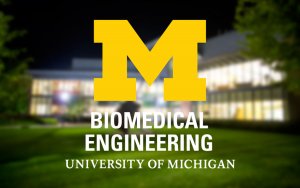Presented By: Biomedical Engineering
Acoustic Methods for Histotripsy Feedback
Final Oral Examination - Jonathan Macoskey

Histotripsy is a therapeutic ultrasound modality that employs clouds of inertial cavitation to noninvasively destroy unwanted tissue. Histotripsy systems are, traditionally, transmit-only systems incapable of receiving ultrasound. For guidance, an ultrasound imaging probe is placed in the center of a histotripsy array. On B-mode ultrasound imaging, the region of tissue destruction appears as a hypoechoic zone after a substantial amount of treatment has occurred. However, this level of histotripsy feedback is insufficient for several reasons. First, histotripsy treatments occur in a 3D space, yet B-mode imaging is 2D. While 3D ultrasound imaging exists, the large footprint of 3D probes would occupy a substantial portion of the acoustic window for therapy. Second, histotripsy-treated lesions only appear hypoechoic on B-mode after a substantial amount of treatment has occurred resulting in poor sensitivity. Developing receive-capable histotripsy arrays would enable a multitude of feedback mechanisms. The overall objective of this dissertation is to develop receive-capable histotripsy systems and new feedback mechanisms enabled by this technology that improve histotripsy treatment efficacy and patient outcomes.
In the first part of this dissertation, the technical details associated with the development of receive-capable histotripsy systems are discussed. First, the challenges of designing highly-parallelized data acquisition systems that are capable of operating over a high dynamic range are outlined and solutions are proposed. Next, the various stages of prototypes that were developed are explored. Finally, two fully-functional receive-capable histotripsy systems are described in detail: a retrofit system that can enable receive-capability for any existing histotripsy system, and a new histotripsy system that incorporates receiver electronics in with high-voltage drivers.
In the second part of this dissertation, several feedback methods for monitoring the extent and progression of histotripsy treatment are discussed. In particular, a new feedback method is investigated, which uses the cavitation collapse time to monitor tissue damage. Upon initiation of a histotripsy bubble cloud, a series of shockwaves are emitted during its initial expansion. Once the bubble cloud expands to a maximum radius, it begins to collapse inward on itself, and, during the final stage of collapse, another shockwave is released. Using a receive-capable histotripsy array, these shockwaves can be acquired thus allowing for a measurement of the overall lifespan of the bubble cloud. This acoustic measurement is optically validated using a high-speed camera. It was found that this lifespan, defined by the cavitation collapse time, correlates directly with the extent of histotripsy treatment. Ex vivo bovine liver samples were treated, and it was found that the change in collapse time directly correlates with hepatocyte destruction.
In the final part of this dissertation, a receive-capable histotripsy system was used to implement acoustic aberration correction. Natural heterogeneities of tissue can result in upwards of 10% variation of sound speed throughout the acoustic path of propagation for histotripsy. These sound speed variations result in acoustic aberrations that significantly defocus histotripsy pulses through phase aberration and result in lowered focal pressure and treatment efficacy in vivo. By using a receive-capable histotripsy system to acquire the expansion shockwave construct from the initial expansion of the histotripsy bubble cloud, time reversal acoustics was implemented to correct for these acoustic aberrations and refocus subsequent histotripsy pulses. Using this method, over 20% of lost pressure due to phase aberration is recovered, and the histotripsy system power required to induce cavitation was reduced by approximately 31.5%.
Chair: Zhen Xu
In the first part of this dissertation, the technical details associated with the development of receive-capable histotripsy systems are discussed. First, the challenges of designing highly-parallelized data acquisition systems that are capable of operating over a high dynamic range are outlined and solutions are proposed. Next, the various stages of prototypes that were developed are explored. Finally, two fully-functional receive-capable histotripsy systems are described in detail: a retrofit system that can enable receive-capability for any existing histotripsy system, and a new histotripsy system that incorporates receiver electronics in with high-voltage drivers.
In the second part of this dissertation, several feedback methods for monitoring the extent and progression of histotripsy treatment are discussed. In particular, a new feedback method is investigated, which uses the cavitation collapse time to monitor tissue damage. Upon initiation of a histotripsy bubble cloud, a series of shockwaves are emitted during its initial expansion. Once the bubble cloud expands to a maximum radius, it begins to collapse inward on itself, and, during the final stage of collapse, another shockwave is released. Using a receive-capable histotripsy array, these shockwaves can be acquired thus allowing for a measurement of the overall lifespan of the bubble cloud. This acoustic measurement is optically validated using a high-speed camera. It was found that this lifespan, defined by the cavitation collapse time, correlates directly with the extent of histotripsy treatment. Ex vivo bovine liver samples were treated, and it was found that the change in collapse time directly correlates with hepatocyte destruction.
In the final part of this dissertation, a receive-capable histotripsy system was used to implement acoustic aberration correction. Natural heterogeneities of tissue can result in upwards of 10% variation of sound speed throughout the acoustic path of propagation for histotripsy. These sound speed variations result in acoustic aberrations that significantly defocus histotripsy pulses through phase aberration and result in lowered focal pressure and treatment efficacy in vivo. By using a receive-capable histotripsy system to acquire the expansion shockwave construct from the initial expansion of the histotripsy bubble cloud, time reversal acoustics was implemented to correct for these acoustic aberrations and refocus subsequent histotripsy pulses. Using this method, over 20% of lost pressure due to phase aberration is recovered, and the histotripsy system power required to induce cavitation was reduced by approximately 31.5%.
Chair: Zhen Xu